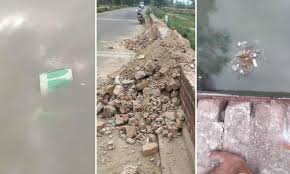The horrors of 1992 were visited once again recently but with a twist in Uttar Pradesh. Unlike the Babri Masjid, this mosque Masjid Gareeb Nawaz Al Maroof, in the district of Barabanki was demolished by official authorities and not goons clad in saffron. In an incendiary move, the local authorities of Ram Sanehi Ghat defied a court order to go ahead and demolish a mosque in the district. The Uttar Pradesh mosque had stood for at least six decades, as indicated by official documents, but it could’ve been older, as the members of its committee claim.

On Monday, 17 May, people were forced by the police and officials to leave the mosque and within minutes, the mosque buildings were crushed under bulldozers. The debris was then collected from the rubble and allegedly thrown into a river. Since then, security services have been deployed in the region to come within a mile of the site of the demolition where the mosque once stood.
As is common knowledge, the State Government of Uttar Pradesh is ruled by the BJP, a Hindu Nationalist party that holds a majority at the Centre as well. The Chief Minister is a hardliner who has been known for his inflammatory remarks against Muslims, such as calling them terrorists and passing legislation that discriminates against Muslims.
According to a local Imam by the name of Maulana Abdul Mustafa, who also serves on the mosque committee, the mosque was in fact hundreds of years old and attracted worshipers in the thousands.
- The district magistrate Adarsh Singh refused to acknowledge the existence of the mosque and went ahead to say; “I do not know any mosque. I know there was an illegal structure. The Uttar Pradesh high court declared it illegal. That’s why the regional senior district magistrate took action. I will not say anything else.”
- On Monday afternoon, 17 May, the administration went ahead to bulldoze the Mosque structures. This time no one stuck around to protest, and the members of the congregation and mosque authorities went into hiding in fear of being arrested.
- Also read:
The district magistrate Adarsh Singh refused to acknowledge the existence of the mosque and went ahead to say; “I do not know any mosque. I know there was an illegal structure. The Uttar Pradesh high court declared it illegal. That’s why the regional senior district magistrate took action. I will not say anything else.”
On 24 April, the Allahabad high court issued an order which stated that in the wake of the upsurge of the pandemic, buildings should be protected from eviction or demolition until 31 May.
The local administration issued a show-cause notice to the mosque committee on 15 March, asking them to present documentary evidence for the ownership of the land and citing a court directive where illegal religious constructions could be demolished if they caused traffic obstructions.
While the committee reportedly did send evidence to support the claim that the mosque was 60 years old, and showed that no mosque structures were obstructing the road, the local administration did not report on to official record.
In the following days, the administration began building a permanent structure to block access to the mosque, say sources. On 19 March, protests and tension ensued in the area after worshippers were denied entry into the mosque for Friday prayers. Over 35 local Muslims who were protesting were arrested and put in jail, where many are still held and FIRs were filed against the demonstrators.
On Monday afternoon, 17 May, the administration went ahead to bulldoze the Mosque structures. This time no one stuck around to protest, and the members of the congregation and mosque authorities went into hiding in fear of being arrested.
The chairman of the Uttar Pradesh Sunni Waqf Board, Zafur Ahmed Faruqi condemned the action of the authorities and said it was an utter violation of high court orders of 24.04.2021. He also called for high-level judicial enquiry.
This grim reality that Muslims had to face in the district occurred only a slight distance from the district of Ayodhya, where the Babri Masjid once stood, and now as the mosque is demolished, the Supreme Court in 2019 ruled that the long-disputed land actually belonged to the Hindus and not Muslims and a new Ram Temple is under construction on the very site.















